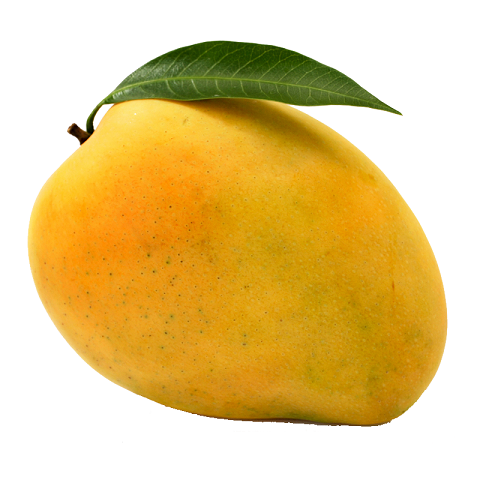- Home
- Crop Knowledge
- Fruits
- Mango
Mango
- Nutrients
- Common Pests
- Crop Selection
- Documents
|
Crop Stage Images |
 |
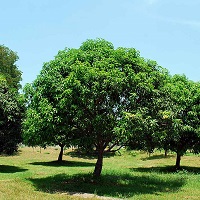 |
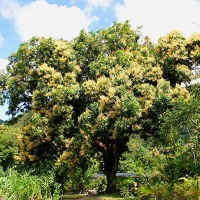 |
|
|---|---|---|---|---|
| Age of the Tree | 1 Year Old | Annual Increase (2-5 years) |
6th Year Onwards | |
|
Nutrients (Kg/Tree) |
FYM | 10 | 10 | 50 |
| N | 0.20 | 0.20 | 1 | |
| P | 0.20 | 0.20 | 1 | |
| K | 0.30 | 0.30 | 1.5 | |
Deficiency of Nutrients:
| Nutrients | Nitrogen (N) | Phosphorus (P) | Potassium (K) | Calcium (Ca) | Magnesium (Mg) |
|---|---|---|---|---|---|
| Nutrients Deficiency | 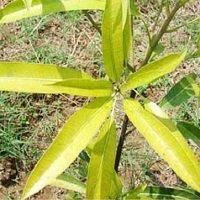 |
 |
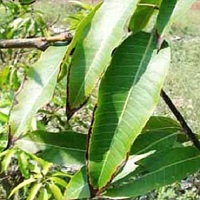 |
 |
 |
| Deficiency Symptoms | 1. Fruits smaller and mature early.
2. Leaves small with general yellowing. 3. Yellow undersized leaves, severe retardation of growth, twigs become yellow in colour. |
1. Retarded growth premature dropping of older leaves partial die-back from the tip small green younger leaves are borne at the tips of the branches.
2. Some branches show die back. 3. Leaf tip necrosis and premature abscission of leaves. |
1. Darkening of leaves reduced growth and vigour.
2. The appearance of white, yellow or orange chlorotic spots in older leaves and distributed irregularly over both under and upper leaf surfaces. 3. Necrotic areas develop along the leaf margins. 4. Dieback with tip burn with small leaves. |
1. Abnormal growth of young leaves and growing points resembling boron deficiency severe deficiency leads to the death of the bud. | 1. Reduction in growth premature defoliation yellowish brown chlorosis featured by a green wedge down the central part of the leaf bronzing starting from the edge of the leaf rounded margin between each pair of lateral veins. |
| Nutrients | Sulphur (S) | Boron (B) | Copper (Cu) | Manganese (Mn) | Zinc (Zn) |
|---|---|---|---|---|---|
| Nutrients Deficiency |  |
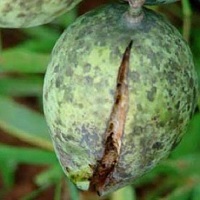 |
 |
 |
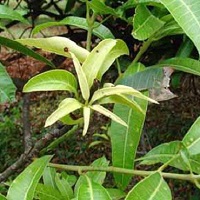 |
| Deficiency Symptoms |
1. Symptoms first appear on young leaves with fading of green colour. 2. Growth is stunted. |
1. Deficiency is common in high rainfall areas, high temperature, soil acidity and calcareous soils. 2. Fruits become brown in colour. 3. The flesh may become soft and watery which cracks down to the centre. |
1. Shoots produced on long drooping S-shaped branches of previous growth are weak lose foliage and die back. | 1. Deficiency appears in the middle of the plant.
2. Interveinal chlorosis of leaves. 3. Reduced growth leaf symptoms appear very late leaves show a yellowish green background with a fine network of green veins on the upper surface and disappearing after a few weeks mature leaves thicker and blunted. 4. Specks of light grey to greyish brown colour appear under mid deficiency. |
1. Leaf blade thickens leaf shape is distorted leaf margin up or down the tip may curve back interveinal areas leaves are usually smaller thickened leaf blade brittle spaced leaves show a rosette appearance.
2. Some twigs die back flower panicles of trees showing little leaf symptoms are usually small irregular in shape drooping spikes. |
| Images Of Pest Life Cycle: | 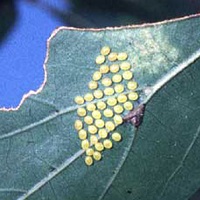 |
 |
 |
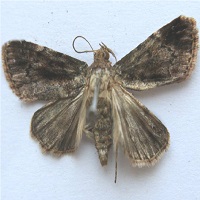 |
|---|---|---|---|---|
| Stages: | Egg | Larvae | Pupae | Adult |
| Mark Of Identification: | The eggs are very small and dull-greenish in colour, and are laid in a scattered manner on the leaves. | There are five larval instars. larvae hibernate in tough, silken, waterproof cocoons in the soil. | Long brown pupae in white silken cocoons remain attached to leaves. | The Moths are grey with a slight olive-green tinge. The abdomen is grey to brownish-grey. |
| Life Cycle: | 4 Days. | 33 Days. | 4-5 Days | 4-5Weeks. |
Management (Pest Control):
| Chemical: | Sprays starting from the last week of July at 15 days interval with Carbaryl (0.2%) or Quinalphos (0.05%) effectively controls the pest. |
|---|---|
| Organic: | Spray G Agro Beau 5gm/lit + G Agro Meta 5ml/lit 2 to 3 spray at 21 days interval. |
| Images Of Pest Life Cycle: | 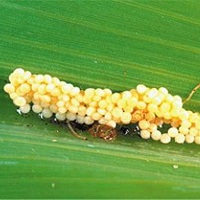 |
 |
 |
 |
|---|---|---|---|---|
| Stages: | Egg | Larvae | Pupae | Adult |
| Mark Of Identification: | Eggs are brownish-white, cylindrical. | Yellowish-white, with the head dark brown and sclerotized, without obvious legs. | Reddish setae on labrum and bases of mandibles and antennae. | Covered with grey to yellowish pubescence on a dark brown to a pitchy surface. |
| Life Cycle: | 1-2 Weeks. | 10-45 Days. | 19-36 Days. | 6 Months. |
Management (Pest Control):
| Chemical: | Prune and destroy affected branches and paste the cut ends with 5% copper oxychloride (50 g / liter of water). |
|---|---|
| Organic: | Spray G Agro Beau 5gm/lit + G Agro Meta 5ml/lit 2 to 3 spray at 21 days interval. |
| Images Of Pest Life Cycle: |  |
 |
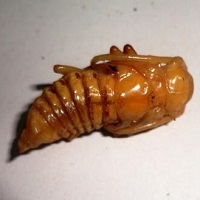 |
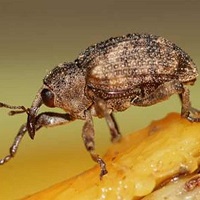 |
|---|---|---|---|---|
| Stages: | Egg | Larvae | Pupae | Adult |
| Mark Of Identification: | Eggs are elliptical. | Small, thick and white, apodus, fleshy, light in colour with dark head.
Five larval instars. Development of the larva is usually completed within the maturing seed. |
Pupation inside the stone. | Adults are weevils with a compact body. |
| Life Cycle: | 5-7 Days. | 90 Days. | 40-50 Days. |
Management (Pest Control):
| Chemical: | Spraying the tree trunks with kerosene oil emulsion after harvest of fruits to kill the adults.
Spraying on young fruits with Dimethoate, Deltamethrine Acephate, Carbaryl and Etofenprox, Azadirachtin and fish oil rosin soap. |
|---|---|
| Organic: | Spray G Agro Beau 5gm/lit + G Agro Meta 5ml/lit 2 to 3 spray at 21 days interval. |
| Images Of Pest Life Cycle: | 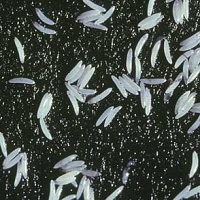 |
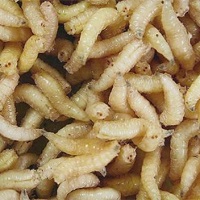 |
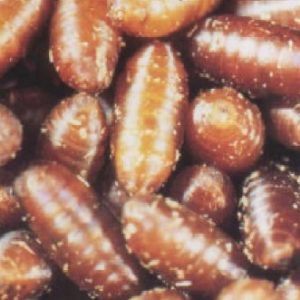 |
 |
|---|---|---|---|---|
| Stages: | Egg | Larvae(Maggot) | Pupae | Adult |
| Mark Of Identification: | Female flies insert eggs under the skin of fruit in clusters. | The white maggot is legless and resembles an elongated cone. The mouth is at the pointed end of the body. | When mature, maggot drops to the ground and pupates in the soil. The puparium is yellowish-brown and seed-like. | Generally, the abdomen has two horizontal black These markings may form a “T” shaped pattern. |
| Life Cycle: | 5-8 Days. | 11-15 Days. | 10 Days. | 10-15 Days. |
Management (Pest Control):
| Chemical: | Application of spray bait (20 ml. malathion +200 g gul +20 Lit. water).
Spraying of adjoining hedges with 0.05% dimethoate or 0.1% carbaryl. After harvesting, dip the fruits in 5% sodium chloride solution for 60 minutes to kill the eggs, if any and also to decontaminate them of insecticide residue if at all present. |
|---|---|
| Organic: | Spray G Agro Beau 5gm/lit + G Agro Meta 5ml/lit 2 to 3 spray at 21 days interval. |
| Images Of Pest Life Cycle: | 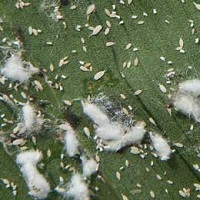 |
 |
 |
|---|---|---|---|
| Stages: | Egg | Nymphs | Adult |
| Mark Of Identification: | Soft-bodied, flat and waxy, mealybugs can also be identified by their oval shape and body segmentation. | The first instar nymphs are also called crawlers. | In general, they have 4 female instars and 5 male instars. |
| Life Cycle: | 22-47 Days. | 45-71 Days. | 78-135 Days. |
Management (Pest Control):
| Chemical: | Soil application of 2% methyl parathion dust to kill newly emerged nymphs.
Spray with 0.05% dimethoate or 0.1% carbaryl. |
|---|---|
| Organic: | Spray G Agro Microfeed L 5gm/lit + G Agro Meta 5ml/lit 2 to 3 spray at 21 days interval. |
| Images Of Pest Life Cycle: |  |
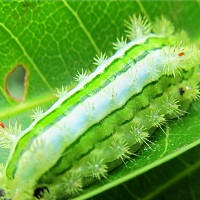 |
 |
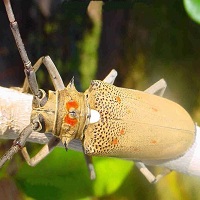 |
|---|---|---|---|---|
| Stages: | Egg | Larvae | Pupae | Adult |
| Mark Of Identification: | Creamy white eggs. | Development of the larvae is rapid. | Reddish setae on labrum and bases of mandibles and antennae. | Adult moths are stout greyish brown in colour with wings having wavy lines. |
| Life Cycle: | 3-4 Days. | 5-6 Days. | Pre-pupal: 2-3 Days.
Pupal : 9-14 Days. |
20-25 Days. |
Management (Pest Control):
| Chemical: | Spray with 0.03% dimethoate. |
|---|---|
| Organic: | Spray G Agro Beau 5gm/lit + G Agro Meta 5ml/lit 2 to 3 spray at 21 days interval. |
| Images Of Pest Life Cycle: |  |
 |
 |
|---|---|---|---|
| Stages: | Egg | Nymphs | Adult |
| Mark Of Identification: | Females lay more eggs and nymphs develop faster during the flowering and fruiting period. | The nymphs are greenish with black or brown markings, cannot fly and move rapidly on the plant. | Adult mango leafhoppers are golden-brown or dark brown, wedge-shaped insects. |
| Life Cycle: | 12-20 Days. | 4-7 Days. | 8-13 Days. |
Management (Pest Control):
| Chemical: | First spray of imidacloprid(0.005%, 0.3 ml per liter of water) should be done at early stages of panicle formation, if hopper population is more than 5 per panicle.
The second spray of thiamethoxam (0.005%, i.e., 0.2 g per litre of water) or acephate (1.5 g per litre of water) should be carried out after fruit set. If substantial hopper population still persists, the third spray of carbaryl(0.15%, i.e., 3 g per litre of water) should be done before the maturity of fruits. Mettarhizium anisopliae @ 5 gm/lit or Neem oil 5 ml/lit may be sprayed against hoppers and Shoot Webber. Do not to spray insecticides (more than 50 per cent flowering): affect the pollinator activity leading to low fruit set. |
|---|---|
| Organic: | Spray G Agro Beau 5gm/lit + G Agro Microfeed L 5gm/lit + G Agro Meta 5ml/lit 2 to 3 spray at 21 days interval. |
| Seed Variety | Characteristics | Season | Crop Yield (ton/ha) |
|---|---|---|---|
| Alphonso | 1. It is also known as Hapoos, this is the most expensive variety of mangoes in India. 2. It has a fibreless pulp and douses into the mouth as a smooth-creamy mango. 3. This variety of mango is popular all over the world. |
May-June | 200-300 Fruit/tree |
| Chaunsa | 1. It is sweet, juicy and very nutritious. 2. The heavenly sweet taste of this mango will make you lick up every drop of its nectar. 3. It is mostly grown in the northern parts of India. |
July end-August | 15.5 |
| Dasehri | 1. It is the oldest variety of Mangoes in India. since its origin can be traced back to almost 200 years ago. 2. The sweet syrup of this mango makes you have at least 2-3 mangoes at a time. |
June-July | 16 |
| Langra | 1. The mother tree of this variety exists in Varanasi. 2. Since the owner of that tree was unfortunately lame, the mango was thus named as “Langra”. 3. This variety is distinctively fibrous, with a unique taste as well. |
Mid-July to August | 16 |
| Safeda or Banganapalli | 1. These mangoes have a very beautiful yellow colour and are sweet and fibreless. 2. It is the most popular variety of mangoes which comes straight from Andhra Pradesh. |
April to June | 80 Kg/tree |
| Kesar | 1. This variety of mangoes is precisely consumed raw or used for making Aamrus. 2. It has a very intense aroma that spreads out in the entire house. |
June-Early July | 7 |
| Neelam | 1. This is one variety that grows throughout the country. 2. It arrives early in the season, the best variety is available only in June. |
May-July | 16 |
| Sindoora | 1. It is reddish in colour at the top has entitled this variety with the name of Sindoora. 2. Extremely juicy and pulpy, this mango is one of the tastiest mangoes one can ever have. |
Mid-May to Mid-June | 80 Kg/tree |

